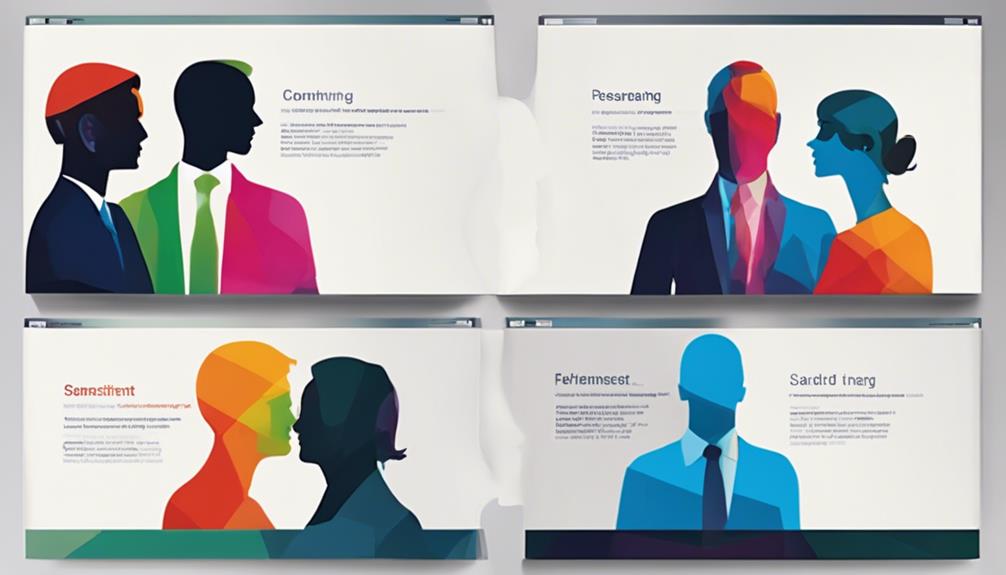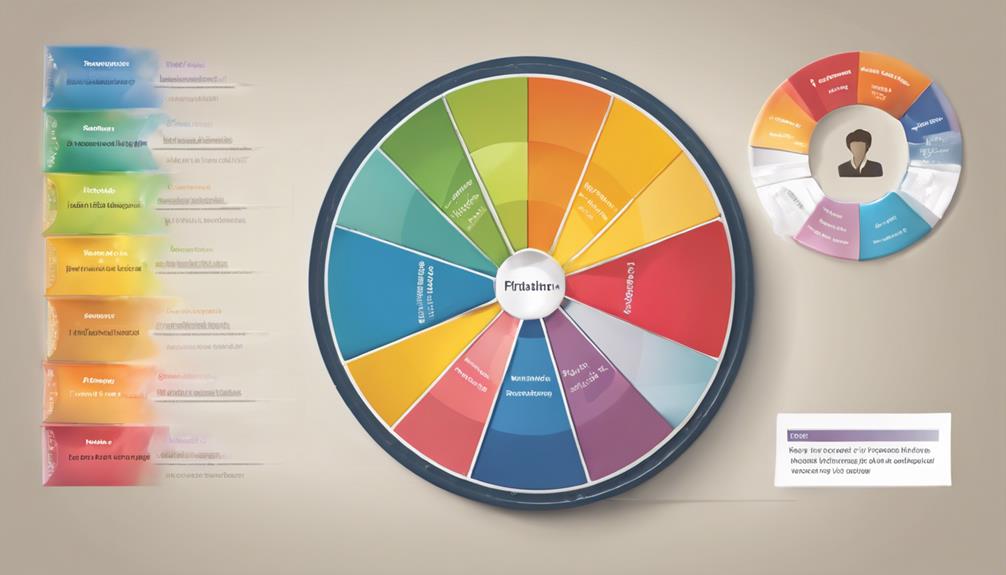When we review the findings of a DISC Sales Assessment, we discover valuable insights about our team members’ behavior patterns, communication preferences, strengths, and weaknesses. This information can play a crucial role in promoting teamwork, boosting efficiency, and maximizing sales success.
However, the real power of the DISC assessment lies in its ability to provide a deeper understanding of our team dynamics and unlock their full potential. By delving into the intricacies of these assessments, we can uncover hidden opportunities for growth and development that can propel our team towards even greater success.
Key Takeaways
- Uncover individual sales styles and strengths, enhancing team performance.
- Tailor sales approaches to match communication preferences, boosting effectiveness.
- Address weaknesses and leverage strengths for optimized sales outcomes.
- Foster collaboration and cohesion by valuing diverse communication styles.
Key Behavioral Tendencies Revealed
Revealing key behavioral tendencies through a DISC sales assessment provides invaluable insights into team members' sales styles and strengths, enabling strategic optimization of sales strategies and team dynamics. By identifying the dominant communication styles and personality types within a team, the assessment lays the foundation for improved communication and enhanced personal development. Understanding the behavioral traits uncovered by the DISC assessment is crucial for tailoring sales approaches to resonate with individual team members.
Team members exhibiting an influential style excel in building rapport and fostering relationships, making them valuable assets in customer-facing roles. Those with a conscientiousness trait prioritize accuracy and precision, ensuring that sales processes are executed meticulously. Individuals displaying a steadiness style bring loyalty and reliability to the team, forming the backbone of consistent customer service. Recognizing and leveraging these diverse behavioral tendencies can lead to more cohesive team dynamics, increased sales effectiveness, and overall organizational success. The insights gained from the assessment pave the way for targeted training programs and tailored strategies that capitalize on each team member's strengths.
Insights Into Communication Styles

Understanding team members' communication styles as revealed by the DISC Sales Assessment is crucial for tailoring sales strategies to effectively engage and connect with each individual's preferences. By identifying whether team members lean towards Dominance, Influence, Steadiness, or Conscientiousness in their communication styles, sales teams gain valuable insights into how best to interact with them. This knowledge enables sales professionals to adapt their approach, ensuring that sales pitches, presentations, and negotiations align with the communication preferences of each team member.
Moreover, recognizing these communication styles not only enhances internal team dynamics but also boosts sales effectiveness. The assessment not only highlights the strengths present in each team member's communication style but also pinpoints areas for improvement. This information empowers teams to refine their communication strategies, resulting in more successful interactions both within the team and with clients. Ultimately, leveraging insights into communication styles obtained from the DISC Sales Assessment can significantly elevate sales performance and foster stronger connections with customers.
Strengths and Weaknesses Identification
Identifying individual strengths and weaknesses through a DISC Sales Assessment enables targeted training and personalized coaching strategies for enhancing sales performance. The assessment uncovers key traits like assertiveness, persuasiveness, and relationship-building skills that contribute to sales success within the team. Understanding these strengths allows for leveraging them effectively in sales situations.
Conversely, weaknesses such as resistance to change, lack of adaptability, or challenges in closing deals can be addressed through tailored training programs. By gaining insights into how team members handle objections and engage with clients, managers can develop specific coaching strategies to enhance individual sales outcomes.
This personalized approach not only improves sales performance but also fosters professional growth by honing in on each team member's unique abilities. Ultimately, by harnessing the knowledge gained from the DISC Sales Assessment, teams can optimize their sales potential and drive greater success in their endeavors.
Enhancing Team Cohesion

To foster strong team cohesion, it is imperative to capitalize on the diverse communication styles and preferences revealed by the DISC Sales Assessment. Understanding these nuances allows us to tailor our interactions, leading to improved team collaboration and more effective problem-solving. By identifying potential conflicts through the assessment, we can proactively implement strategies for resolution, thereby enhancing overall team dynamics. Additionally, when team members appreciate and leverage each other's strengths uncovered by the assessment, it not only boosts morale but also fosters a sense of unity and mutual respect. Recognizing and valuing diverse behavioral styles within the team creates a harmonious and inclusive work environment where everyone feels heard and valued. Let's delve deeper into how the DISC Sales Assessment can serve as a catalyst for strengthening team cohesion:
| Communication Styles | Team Collaboration | Problem-Solving | Conflicts Resolution |
|---|---|---|---|
| Diverse and tailored | Enhanced efficacy | Strategic | Proactive strategies |
Maximizing Sales Team Productivity
Capitalizing on the insights gained from the DISC Sales Assessment, we can strategically enhance our sales team's productivity to drive towards exceeding our targets. By leveraging individual strengths and understanding team dynamics revealed by the assessment, we can tailor our approach to maximize sales performance.
To achieve this, we will:
- Identify and capitalize on individual strengths: Recognizing each team member's unique sales style and strengths allows us to assign tasks that align with their abilities, increasing efficiency and motivation.
- Implement targeted training programs: Developing targeted training sessions based on the assessment results will address areas needing improvement, enhancing overall team performance and effectiveness in sales interactions.
- Foster a culture of continuous improvement: Encouraging open communication, sharing best practices, and providing regular feedback based on the assessment findings will nurture a collaborative environment that drives towards surpassing our sales targets.
Frequently Asked Questions
What Does a Disc Assessment Tell You?
A DiSC assessment tells us about individual behavioral styles, communication preferences, decision-making approaches, and problem-solving methods. Insights gained illuminate team dynamics, strengths, conflict areas, and performance opportunities. Tailoring strategies based on DiSC profiles enhances teamwork and fosters a positive environment.
What Is the Disc Assessment for Team?
Exploring the DiSC assessment for teams uncovers unique behavioral styles influencing how individuals engage within the team dynamic. It unveils diverse approaches to tasks, communication methods, and conflict resolution, fostering synergy.
What Are the Benefits of a Disc Assessment?
Understanding the benefits of a DiSC assessment is crucial for team success. It uncovers communication styles, problem-solving approaches, and conflict resolution strategies. DiSC enhances teamwork, aligns with goals, fosters collaboration, and improves dynamics.
How Does Your Knowledge of DISC Help You in Leading or Working With Your Team Mates Who Are Uniquely Different in Their Personalities?
Understanding our team's diverse personalities through DISC enables us to tailor leadership approaches and communication effectively. We appreciate varied strengths, fostering collaboration. This knowledge guides conflict resolution, promoting a harmonious work environment.
How Can a DISC Sales Assessment Help with Team Building Activities?
A DISC sales assessment can greatly benefit team building disc activities by identifying each team member’s communication and behavioral style. Understanding these differences can help teams work more cohesively, improve collaboration, and enhance overall sales performance. By recognizing individual strengths, teams can effectively leverage each member’s unique skills in sales and team building disc activities.
Conclusion
In conclusion, a DISC Sales Assessment can unlock a treasure trove of insights about your team's dynamics and performance. By understanding behavioral tendencies, communication styles, strengths, and weaknesses, you can enhance team cohesion and maximize productivity.
However, remember, the real value lies not just in the assessment itself, but in how you apply these insights to foster a positive work environment and drive organizational success. So, don't just assess – act upon it!
Felicity, our Author, pens in-depth articles and guides that delve into the heart of personal discovery. Her narrative-driven approach weaves together theory, practice, and personal anecdotes, making the journey of self-exploration both relatable and inspiring. Felicity’s contributions help illuminate the path for those seeking a deeper understanding of themselves and their relationships.










